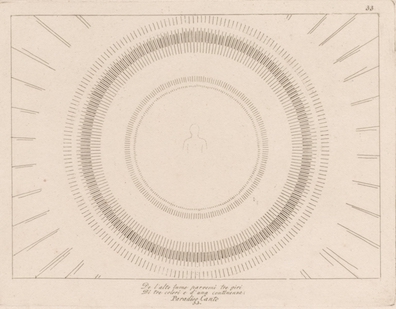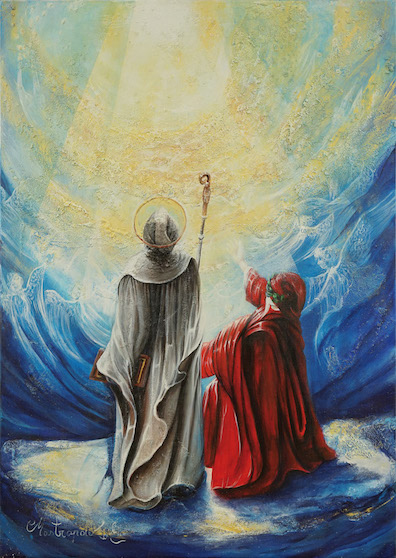Various scenes in
the
Paradiso feature concentric circles, both angels and
human souls coming together to form this shape. In the Appendix
to
Joyce and Dante: The Shaping Imagination, Mary
Reynolds offers two possible analogues to the scene in
Ithaca.
Canto 14 shows Dante in conversation with
Thomas Aquinas,
who appears as one starlike light in two bright rings circling
one another: "the holy circles showed new joy in wheeling / As
well as in their wondrous song" (23-24). Reynolds does not cite
it, but the canto opens with a similar image: Dante's thoughts,
when he has heard what Thomas has to say, move like water
ripples in a round container, "From center to rim, as from rim
to center," when it is "struck from without or from within"
(1-3). There are more concentric circles in canto 28, when Dante
sees God as an infinitesimal point of intensely bright light
surrounded by nine fiery rings of angels, revolving at different
speeds.
Reynolds' appendix merely quotes lines from Joyce's works
followed by similar ones from Dante's, without commenting, so
readers can only infer the thought processes behind her choices,
but it is hard to see what precise relevance the soul-rings or
the angel-rings could have to the rings of light on the Blooms'
bedroom ceiling. The concentric circles at the end of
Paradiso
33 offer more promising grist for the allusive mill. (Reynolds
does not cite them in her appendix, though she does mention them
earlier when she discusses Dantean circles in
Finnegans Wake.)
The canto shows two people––Dante and his final guide, St.
Bernard of Clairvaux––gazing up toward God. Bernard prays to the
Virgin Mary that "by lifting up his eyes, / he may rise higher
toward his ultimate salvation" (26-27). Dante looks "upward"
(50) to where Bernard and Mary are gazing, and his sight,
"becoming pure, / rose higher and higher through the ray of the
exalted light" (52-54). In a way that he cannot communicate or
even remember, his sight penetrates to the infinite source of
all being.
The experience culminates in a vision of three "circlings" (
giri)
somehow contained in one another:
In the deep, transparent essence of the lofty Light
there appeared to me three circles
having three colors but the same extent,
and each one seemed reflected by the other
as rainbow is by rainbow, while the third seemed fire,
equally breathed forth by one and by the other. (115-20)
Amid this mystery of Father, Son, and Holy Spirit is inscribed
the other central mystery of Christian doctrine, the unity of
God and Man in the incarnate Christ. After some gazing, the
"circling" seems, "within itself and in its very color, to be
painted with our likeness, / so that my sight was all absorbed
in it" (127, 130-32). Like a geometer attempting to square the
circle, the pilgrim struggles "to see how the image fit the
circle / and how it found its where in it" (137-38). He fails
intellectually, but a divinely granted flash of insight gives
him what he seeks, obliterating his sense of self and subsuming
his will and desire, "like wheels revolving" (143), in the Love
that turns the stars.
In Joyce's scene, Bloom and Molly gaze upward into rings of
light that are "
inconstant," with "
varying gradations
of light and shadow"––a commonly experienced effect of
lampshades. Perhaps Joyce meant to contrast these imperfect
circles with the transcendently significant ones of
Paradiso
33, or perhaps he intended to evoke Dante's impression of
colored lights mysteriously shimmering into one another while
remaining separate. Similar questions of correspondence or
non-correspondence are raised by the images' referents. As he
looks at the lights Dante struggles to understand the Trinity
and the Incarnation. The Blooms, by contrast, are thinking about
what Bloom has been doing all day (such questions about Molly's
day remain unasked), about Molly's inquisitorial interest in
such matters ever since Milly's first period, and about the sad
state of their sexual relationship since the death of Rudy.
Every Joycean allusion invites readers to ask how far the
correspondence may extend. Does the
Ithaca passage offer
an analogue to Dante's effort to see how the human image is
inscribed in the divine one? It probably does, since both
Leopold and Marion are asking themselves whether they still have
a place in this marriage, and are struggling to see how they fit
in it. Does some Trinitarian relationship figure in their
thoughts? This seems less certain, but possible. Just before the
long paragraph devoted to Bloom's day, Molly's interrogation,
Milly's menstruation, Rudy's death, and sex, a short one has
asked what is the "salient point" of Bloom's narration. Answer:
"Stephen Dedalus." Husband and wife may well be wondering how
Stephen could fit into their marital circle. In
Eumaeus
and
Ithaca Bloom thinks that bringing the young man into
his house might solve certain problems, and in
Penelope Molly
entertains similar thoughts. Stephen shows no sign of wanting
any part in a triangle, sexual or otherwise, but for both Blooms
it seems to hold out some hope of marital rejuvenation.
Or, to consider a different Trinity, could Milly be contained in
the circles? The narrative has just described how her pubescence
has altered behavioral patterns in the marriage, and earlier in
Ithaca Bloom has recalled a time when a drop of his
daughter's spit made "
concentric circles of waterrings,"
precisely like the image at the beginning of canto 14. A
Bloom-Molly-Milly trinity on the ceiling would constitute an
emblem of the current family unit. A Bloom-Molly-Stephen trinity
would convey the potential union of the novel's three
protagonists: Father, Mother, and surrogate Son.
Such human mysteries may prove as impossible to parse out as
Dante's theological questions, but in both works the overall
promise of the circles seems clear enough. Dante's offer him
insight into the Love that moves the stars. Joyce's, if they are
cut from the same cloth, suggest that the Blooms still see
something worth saving in their marriage. Dante's vision
requires that he demonstrate his understanding of faith (canto
24), hope (25), and love (26). With enough of these three
virtues, the Blooms too may find their way through a rough patch
to a secular approximation of heaven.
Ithaca begins with Bloom and Stephen visualized from
far above charting squiggly "parallel courses" from the
Customhouse to Eccles Street. It ends with Bloom and Molly
tracing lines through unbounded space on squiggly parallel
courses described by the earth's rotation, revolution, and
inclination "at an angle of 45° to the terrestrial equator"
and positioned 180° to one another in the bed. The scientific
worldview implicit in the chapter's mathematics and astronomy
provides a kind of framing context for Joyce's appropriation
of Dante's image, whose parallel circles embody the perfection
of changeless being. In the world of change nothing is
perfect, but even in shadows playing on a ceiling life holds
out provisional promises of fulfillment.


